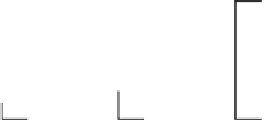Agriculture Reference
In-Depth Information
4
3.5
3
2.5
Separately
Simultaneously
2
Figure 9.1
Effect of feeding a range
of browse species, either
separately or simultaneously, on
the relative intake of goats versus
sheep (recalculated from the data
of Rogosic et al., 2006a).
1.5
1
0.5
0
Arbutus
unedo
Erica
multiflora
Juniperus
phoeniceae
Pistacia
lentiscus
Quercus ilex
Viburnum
tinus
Mayes, 2005). A recent study in Spain (Celaya et al., 2007)
avoided such problems in co-grazing cows, ewes, and does
in heathland in Spain, by estimating diet selection directly,
using plant wax alkanes as markers (see Dove and Mayes,
2005 ). Their data confi rm behavioral observations. The
herbaceous component made up 75-90% of the intake of
cows whereas in ewes, shrubs made up 36-59% of the diet,
and in does, 49-85% of the diet. There is thus little doubt
that, where diet choice is possible, goats will consume
more browse than sheep and particularly, more than cattle.
100
80
60
Cattle
Sheep
Goats
40
20
0
Factors Infl uencing Diet Selection
Rainy
Post-rainy
Dry
Figure 9.2
Comparison of the time spent
browsing by cattle, sheep, and goats in a natural
pasture in the Sahelian region of Africa
(recalculated from the data of Sanon et al.,
2007).
S
EASON
OF
Y
EAR
AND
S
PECIES
C
OMPOSITION
OF
THE
P
LANT
B
IOMASS
In many studies, selection of particular plant species in the
diet has been, in part at least, a function of the seasonal
availability of different species. As would be expected, the
species composition of the biomass, both in its own right
and as infl uenced by season, has a marked effect on diet
selection by the goat. The preference of goats for particular
plant species also depends on whether different plants are
fed together or separately. For example, Rogosic et al.
(2006a) offered six different browse species to either
housed goats or housed sheep. When the shrubs were
offered individually, goats always ate more than sheep.
Recalculation of their data indicates that the ratio of
goat : sheep intakes (both expressed as g DM/kg LW)
ranged from 1.35-1.93 across the different plant species
(Figure 9.1). When all six plant species were offered simul-
taneously to the two species of animals, goats again always
ate more than sheep, but the intake ratios ranged from
1.36-3.58 between plant species. In other words, the pref-
erence for different plant species was more extreme when
all plant species were offered together. This means that
caution is required when extending indoor data obtained
by feeding individual plant species to fi eld situations where
a range of plant species is on offer at the same time.
Marked seasonal effects on diet composition have
been reported in many studies. For example, Sanon et al.
(2007) reported data for goats, sheep, and cattle grazing
natural pasture in the Sahelian region of Africa. Their data
for the time spent browsing have been recalculated as a
percentage of the total feeding time; differences between
animal species and seasons are shown in Figure 9.2.
As the seasons progressed, there was little change in the
time cattle spent browsing, despite the progressive loss of
the herbaceous component of the plant biomass. The
apparent increase in browsing by cattle in the dry season
was due more to a reduction in their time spent feeding































































